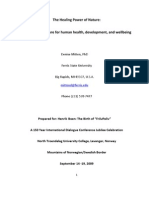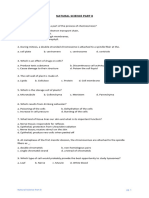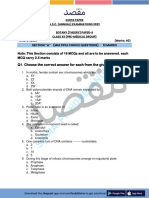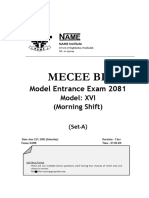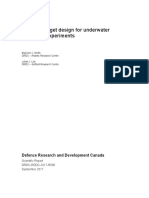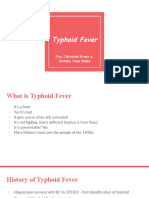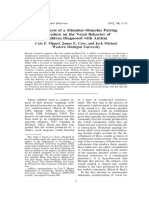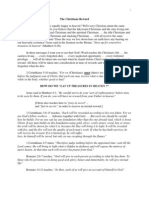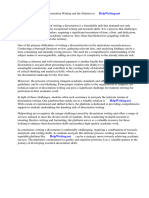13-12th Group A Half Book Bio Chap 15+25+17+27,16+21+26
13-12th Group A Half Book Bio Chap 15+25+17+27,16+21+26
Uploaded by
Raees Ali KhanCopyright:
Available Formats
13-12th Group A Half Book Bio Chap 15+25+17+27,16+21+26
13-12th Group A Half Book Bio Chap 15+25+17+27,16+21+26
Uploaded by
Raees Ali KhanOriginal Title
Copyright
Available Formats
Share this document
Did you find this document useful?
Is this content inappropriate?
Copyright:
Available Formats
13-12th Group A Half Book Bio Chap 15+25+17+27,16+21+26
13-12th Group A Half Book Bio Chap 15+25+17+27,16+21+26
Uploaded by
Raees Ali KhanCopyright:
Available Formats
Test # 13 (1st Half Book) Biology: 12th
HIZB-UR-REHMAN ISLAMIC
SCIENCE COLLEGE
Paper: Biology ( O b j e c t i v e ) Chap: 15+17+25+27 (Long) Total Marks:17
Class: 2 n d Year and 16+21+26(short) Time: 10 m
Name: Roll No.
Q.1: MCQs
1. The percentage of freshwater in lakes is:
a. 1% b. 2% c. 3% d. 10%
2. Grasslands of tropical climate having woody trees are called:
a. Prairies b. Boreal c. Savanna d. Tundra
3. Desert ecosystem occurs in region where annual rainfall is less than:
a. 25-50 cm b. 5-10 cm c. 15-20 cm d. 250-270 cm
4. The zone where enough light penetrates to support the photosynthesis is:
a. Littoral zone b. Limnetic zone c. Profundal zone d. Benthic zone
5. Which one of the following is foliage lichen?
a. Tortula b. Dermatocarpon c. Polytrichum d. Rhizocarpon
6. All populations within an ecosystem are known as:
a. Biosphere b. Biome c. Succession d. Community
7. The whole of world land is called:
a. Hydrosphere b. Biosphere c. Lithosphere d. Atmosphere
8. The phase of mitosis which ensures equal distribution of chromatids in daughter cells is:
a. Prophase b. Metaphase c. Anaphase d. Telophase
9. Meiosis in plants generally take place during the formation of:
a. Gametes b. Spores c. Zygote d. Embryo
10. The temperature more effective for vernalisation is:
ABDUL WAJID 0313-4856103
Test # 13 (1st Half Book) Biology: 12th
a. 4°C b. 8°C c. 12°C d. 16°C
11. The shell over the thick egg is secreted as it passes through:
a. Ovary b. Oviduct c. Uterus d. Style
12. The plant hormone that inhibits the growth of lateral shoots:
a. Cytokinin b. Gibberellin c. Auxin d. Ethene
13. The processes conducting impulses away from the cell body are called:
a. Dendrites b. Nissl’s granules c. Cell body d. Axon
14. In human relay centre is located at:
a. Fore brain b. Mid brain c. Hind brain d. Cerebrum
15. Cockroach excrete nitrogenous wastes in the form of:
a. Ammonia b. Urea c. Uric acid d. All of these
16. Contractile vacuole is found in:
a. Plants b. Fresh water c. Terrestrial animals d. Marine animals
protozoa
17. Arginase splits arginine to form urea and:
a. Citrulline b. Ornithine c. Ammonia d. Arginosuccinate
ABDUL WAJID 0313-4856103
Test # 13 (1st Half Book) Biology: 12th
HIZB-UR-REHMAN ISLAMIC SCIENCE COLLEGE
Paper: Biology ( S u b j e c ti v e ) Total Marks:68
Class: 2 n d Year (Group A) Time: 2:30
Chap:15+17+25+27 and 16+21+26(short questions)
Part I: Give short answers of any 15 questions. 22x2=44
1. What are excretophores?
2. Describe function of Malpighian tubules.
3. What are juxtamedullary nephrons?
4. Differentiate between osmoconformers and osmoregulators.
5. what do you know about nuclear energy?
6. What are poikilotherms?
7. What is metanephridium?
8. Differentiate between sapwood and heartwood.
9. Define nutation.
10. How tendon differ from ligament?
11. Describe rickets.
12. Differentiate between nerve and ganglia.
13. What is action on nicotine on coordination?
14. Differentiate between chemoreceptors and mechanoreceptors.
15. Give functions of androgens.
16. Name hormones released from adrenal gland.
17. Explain parasympathetic nervous system.
18. Explain pachytene stage of meiosis.
19. When and how phragmoplast originates?
20. Give symptoms of turner’s syndrome.
21. Differentiate between benign and malignant tumor.
22. How does cell death help in development of multicellular organism?
23. What is the effect of moderate grazing on grassland?
24. Differentiate between nitrification and denitrification.
25. Define humus.
26. How community is different from population?
ABDUL WAJID 0313-4856103
Test # 13 (1st Half Book) Biology: 12th
27. What type of animal life is found in tundra?
28. Characterize profundal zone of fresh water lakes.
29. What is taiga?
30. Give impact of mismanaged agricultural ecosystem.
31. Differentiate between altitude and latitude.
32. Name any three factors which upset the balance of nutrient cycle.
33. Give four effects of acid rain.
Part II: Give detailed answer of any two questions. 6x4=24
1. Explain thermoregulation in mammals.
2. Describe excretion in plants.
3. Sketch nephron and explain its functions.
4. What is resting membrane potential? How is it maintained?
5. Describe the transmission of nerve impulse through synapse.
6. Sketch and explain nitrogen cycle.
7. Explain stages of succession.
8. Discuss greenhouse effect and its consequences.
9. Describe importance of forests.
ABDUL WAJID 0313-4856103
You might also like
- Answer Key Nat ReviewerDocument17 pagesAnswer Key Nat ReviewerFermina Cacho87% (23)
- Autopsy ReportDocument4 pagesAutopsy Reporteethen33% (3)
- Mendel Biology Mock ExamDocument3 pagesMendel Biology Mock Examopeyemi ajayiNo ratings yet
- Preparationofpotassiumtrisoxalateferrateiitrihydrate 140328134711 Phpapp02Document15 pagesPreparationofpotassiumtrisoxalateferrateiitrihydrate 140328134711 Phpapp02Guru P MNo ratings yet
- NZICC Fire Engineering Peer ReviewDocument11 pagesNZICC Fire Engineering Peer ReviewStuff NewsroomNo ratings yet
- The Healing Power of Nature: The Need For Nature For Human Health, Development, and WellbeingDocument55 pagesThe Healing Power of Nature: The Need For Nature For Human Health, Development, and WellbeingKlausEllegaard11100% (3)
- 13-12th Group B Half Book Bio Chap 15+25+27,19+21Document4 pages13-12th Group B Half Book Bio Chap 15+25+27,19+21Raees Ali KhanNo ratings yet
- 15-12th Full Book BioDocument4 pages15-12th Full Book BioRaees Ali KhanNo ratings yet
- 11-12th Bio Chap 15+25 Homeostasis+ecosystemDocument2 pages11-12th Bio Chap 15+25 Homeostasis+ecosystemRaees Ali KhanNo ratings yet
- Pu 1 Five Model Papers New PatternDocument11 pagesPu 1 Five Model Papers New Patternlegendofjoker1234No ratings yet
- The Creators College of Science & Commerce: 1 TermDocument2 pagesThe Creators College of Science & Commerce: 1 TermJhangir Awan33% (3)
- 12th Bio Chap 15 HomeostasisDocument3 pages12th Bio Chap 15 HomeostasisRaees Ali KhanNo ratings yet
- 10-12th Bio Chap 19 Grwoth and DevelopmentDocument2 pages10-12th Bio Chap 19 Grwoth and DevelopmentRaees Ali KhanNo ratings yet
- Natural Science Part 8 R 50Document6 pagesNatural Science Part 8 R 50Jojimar JulianNo ratings yet
- 12-12th Bio Chap 25+27 Ecosystem+man and EnvironmentDocument2 pages12-12th Bio Chap 25+27 Ecosystem+man and EnvironmentRaees Ali KhanNo ratings yet
- Mot It Hang 21 Trial BioDocument26 pagesMot It Hang 21 Trial Biotxhfn9hfqqNo ratings yet
- 12th Bio Chap 18 REPRODUCTIONDocument2 pages12th Bio Chap 18 REPRODUCTIONRaees Ali KhanNo ratings yet
- Xii Botnay-II - Guess Paper 2023 - Sigma FT HomelanderDocument5 pagesXii Botnay-II - Guess Paper 2023 - Sigma FT HomelanderAbdul RaqeebNo ratings yet
- 1.botnay IDocument3 pages1.botnay Ifatima sameenNo ratings yet
- A.ANBU M.SC.,B.ED., PH: 8508429396 Vivek Vidyalaya Matric Higher Secondary SchoolDocument6 pagesA.ANBU M.SC.,B.ED., PH: 8508429396 Vivek Vidyalaya Matric Higher Secondary SchoolSilva scary svNo ratings yet
- Biology 1 Post-Test: DIRECTIONS: Select The Best Answer To Each of TheDocument3 pagesBiology 1 Post-Test: DIRECTIONS: Select The Best Answer To Each of TheGette AcupanNo ratings yet
- 9-12th Bio Chap 24 EvolutionDocument2 pages9-12th Bio Chap 24 EvolutionRaees Ali KhanNo ratings yet
- Botany Paper IDocument3 pagesBotany Paper IAsad Ali BalochNo ratings yet
- Cell MCQDocument12 pagesCell MCQFave EsperanzaNo ratings yet
- Atural ScienceDocument4 pagesAtural ScienceShaiza Mae LigayanNo ratings yet
- Section 1: Major Paper: Chemistry:: ACADEMIC YEAR: 2015/2016 Department: BiologyDocument8 pagesSection 1: Major Paper: Chemistry:: ACADEMIC YEAR: 2015/2016 Department: BiologyGhislainNo ratings yet
- 7MECEEBL Q 2081.03.08 M-1Document16 pages7MECEEBL Q 2081.03.08 M-1sonukewat9807549427No ratings yet
- 1-12th Bio Chap 25 EcosystemDocument2 pages1-12th Bio Chap 25 EcosystemRaees Ali KhanNo ratings yet
- 12th Bio Important ALPDocument15 pages12th Bio Important ALPAdnan RafiqNo ratings yet
- Eds McqsDocument51 pagesEds Mcqsosmosis.2896No ratings yet
- Be101 Biological Science For Engineers - Iii - Sem (SP22)Document8 pagesBe101 Biological Science For Engineers - Iii - Sem (SP22)MAYANK SengarNo ratings yet
- s6 Biology Paper 1Document19 pagess6 Biology Paper 1Tusiime RobertNo ratings yet
- Diagnostic-test-Q1 - SCIENCE 9Document3 pagesDiagnostic-test-Q1 - SCIENCE 9Yow200sNo ratings yet
- Science G12 DappDocument10 pagesScience G12 DappChester Austin Reese Maslog Jr.No ratings yet
- G6 Science ReviewersDocument23 pagesG6 Science ReviewersArmaden Mamandi100% (3)
- GED A.3. Drill 1 AKDocument8 pagesGED A.3. Drill 1 AKRose ParsamentoNo ratings yet
- Science Eng MediumDocument9 pagesScience Eng Mediumrandimamarasinghe1997No ratings yet
- QPDocument73 pagesQPEnd Semester Theory Exams SathyabamaNo ratings yet
- Test Biology and Environmental ScienceDocument5 pagesTest Biology and Environmental ScienceJeijei AgustinNo ratings yet
- Physics OnemarkDocument6 pagesPhysics Onemarkakilanrider17No ratings yet
- 2nd-Quarter-Final-Exam-Earth-And-Life-Science (2) .FinalDocument3 pages2nd-Quarter-Final-Exam-Earth-And-Life-Science (2) .FinalNiño BelanoNo ratings yet
- Gensci Mock TestDocument8 pagesGensci Mock TestjuliaNo ratings yet
- Third Quarter Exam - Science 10 Carnation GreenDocument8 pagesThird Quarter Exam - Science 10 Carnation GreenGabriel HolgadoNo ratings yet
- Earth and Life ScienceDocument9 pagesEarth and Life ScienceJoel GarciaNo ratings yet
- Uace Bio 1 Acceiteka Mocks (2016-2019Document80 pagesUace Bio 1 Acceiteka Mocks (2016-2019masemvirginNo ratings yet
- 14 SET QuestionDocument16 pages14 SET Questionsonukewat9807549427No ratings yet
- Double Blaster Pro V1Document3 pagesDouble Blaster Pro V1kunihirabyaruhangqNo ratings yet
- Page 1 of 13Document13 pagesPage 1 of 13OurLady ConsolataNo ratings yet
- Natural Science Part 6 R 50Document6 pagesNatural Science Part 6 R 50Jojimar JulianNo ratings yet
- XI Biology QPDocument4 pagesXI Biology QPPriyanshu BadhiaNo ratings yet
- Year End Test in Science 9: Republic of The Philippines Region III Guzmanville, Sto. Cristo, City of San Jose Del MonteDocument5 pagesYear End Test in Science 9: Republic of The Philippines Region III Guzmanville, Sto. Cristo, City of San Jose Del Monteberith grace magcalasNo ratings yet
- LET Reviewer Biology Part 1Document7 pagesLET Reviewer Biology Part 1Michelle Lumabot100% (1)
- 1st Exam Science-9Document5 pages1st Exam Science-9Margie AbogadoNo ratings yet
- CCM 3111 Cell Biology and GeneticsDocument5 pagesCCM 3111 Cell Biology and Geneticsy mugambiNo ratings yet
- Reviewer in PHA611: Pharmaceutical Botany With Taxonomy Multiple ChoicesDocument8 pagesReviewer in PHA611: Pharmaceutical Botany With Taxonomy Multiple ChoicesEza SongahidNo ratings yet
- Higher Secondary First Year Botany Model Question Paper: Standard: XI Time: 2 Hours Maximum Marks: 70Document4 pagesHigher Secondary First Year Botany Model Question Paper: Standard: XI Time: 2 Hours Maximum Marks: 70physicspalanichamyNo ratings yet
- Class 9th BioDocument1 pageClass 9th Biokumarbajrang209No ratings yet
- 8th Class Biology Paper MCQS TypeDocument3 pages8th Class Biology Paper MCQS Typemukhtar ullahNo ratings yet
- Chapter 1: The Structure and Function of CellsDocument24 pagesChapter 1: The Structure and Function of CellsLeigh018No ratings yet
- TEAS Science Practice ExamDocument10 pagesTEAS Science Practice Examalicia100% (1)
- Sample Bilio QuizDocument5 pagesSample Bilio QuizEllie PamintuanNo ratings yet
- Diagnostic Test: Science 10Document23 pagesDiagnostic Test: Science 10Cecil DayoanNo ratings yet
- $RIYHQ5ADocument3 pages$RIYHQ5AnehaulagappanNo ratings yet
- O Level Biology Practice Questions And Answers: Ecology And Our Impact On The EcosystemFrom EverandO Level Biology Practice Questions And Answers: Ecology And Our Impact On The EcosystemNo ratings yet
- Themes of Waste LandDocument24 pagesThemes of Waste LandRaees Ali KhanNo ratings yet
- Literary ModernismDocument3 pagesLiterary ModernismRaees Ali KhanNo ratings yet
- 12-12th Bio Chap 25+27 Ecosystem+man and EnvironmentDocument2 pages12-12th Bio Chap 25+27 Ecosystem+man and EnvironmentRaees Ali KhanNo ratings yet
- 10-12th Bio Chap 19 Grwoth and DevelopmentDocument2 pages10-12th Bio Chap 19 Grwoth and DevelopmentRaees Ali KhanNo ratings yet
- 9-12th Bio Chap 24 EvolutionDocument2 pages9-12th Bio Chap 24 EvolutionRaees Ali KhanNo ratings yet
- 8-12th Bio Chap 22+27 Genetics (B) + Man & EnvironmentDocument3 pages8-12th Bio Chap 22+27 Genetics (B) + Man & EnvironmentRaees Ali KhanNo ratings yet
- 7-12th Bio Chap 22 Genetics (A)Document2 pages7-12th Bio Chap 22 Genetics (A)Raees Ali KhanNo ratings yet
- 1-12th Bio Chap 25 EcosystemDocument2 pages1-12th Bio Chap 25 EcosystemRaees Ali KhanNo ratings yet
- 5-12th Bio Chap 17 Coordination & Control (B)Document2 pages5-12th Bio Chap 17 Coordination & Control (B)Raees Ali KhanNo ratings yet
- 6-12th Bio Chap 18 ReproductionDocument3 pages6-12th Bio Chap 18 ReproductionRaees Ali KhanNo ratings yet
- 4-12th Bio Chap 17 Coordination & Control (A)Document2 pages4-12th Bio Chap 17 Coordination & Control (A)Raees Ali KhanNo ratings yet
- 12th Bio Chap 18 REPRODUCTIONDocument2 pages12th Bio Chap 18 REPRODUCTIONRaees Ali KhanNo ratings yet
- 12th BIO Chap 22 GENETICS ADocument3 pages12th BIO Chap 22 GENETICS ARaees Ali KhanNo ratings yet
- 12th Bio Chap 27 Man and His EnvironmentDocument5 pages12th Bio Chap 27 Man and His EnvironmentRaees Ali KhanNo ratings yet
- 12th Bio Chap 16 Support and Movement BDocument3 pages12th Bio Chap 16 Support and Movement BRaees Ali KhanNo ratings yet
- 12th Bio Chap 16 Support and Movement (Long)Document3 pages12th Bio Chap 16 Support and Movement (Long)Raees Ali KhanNo ratings yet
- 12th Bio Chap 16 Support and Movement ADocument3 pages12th Bio Chap 16 Support and Movement ARaees Ali KhanNo ratings yet
- Joseph Andrews Book 2 Chapters 1 9 Story Text and Critical AnalysisDocument41 pagesJoseph Andrews Book 2 Chapters 1 9 Story Text and Critical AnalysisRaees Ali KhanNo ratings yet
- 12th BIO Chap 22 GENETICS BDocument3 pages12th BIO Chap 22 GENETICS BRaees Ali KhanNo ratings yet
- Thomas Hardy As A Great NovelistDocument7 pagesThomas Hardy As A Great NovelistRaees Ali Khan100% (1)
- 12th Bio Chap 15 HomeostasisDocument3 pages12th Bio Chap 15 HomeostasisRaees Ali KhanNo ratings yet
- A Study On Women Entrepreneurs in Nagpur (Rajashree Kale 23) Final ArDocument6 pagesA Study On Women Entrepreneurs in Nagpur (Rajashree Kale 23) Final Arrajashree kaleNo ratings yet
- Ship-Like Target Design For Underwater Explosion Experiments PDFDocument92 pagesShip-Like Target Design For Underwater Explosion Experiments PDFFernando Raúl LADINONo ratings yet
- Typhoid Fever: Pua, Christian Franz A. Quilala, Gian MailoDocument24 pagesTyphoid Fever: Pua, Christian Franz A. Quilala, Gian MailoGNCDWNo ratings yet
- GR The Rabbit Proof FenceDocument68 pagesGR The Rabbit Proof Fenceau4714912No ratings yet
- Guide To Mass EvidenceDocument229 pagesGuide To Mass EvidenceErik C BryanNo ratings yet
- MARTE Tutorial SDL07 PDFDocument44 pagesMARTE Tutorial SDL07 PDFantedeguenomNo ratings yet
- BallbDocument36 pagesBallbDIVYANSH SAHU BA LLB (HONOURS)No ratings yet
- I Don't Believe in SamsaraDocument3 pagesI Don't Believe in SamsaraVAPE么 MysticNo ratings yet
- Nakshatra Chintamani by Chandrakant R BhatttpdfDocument177 pagesNakshatra Chintamani by Chandrakant R BhatttpdfSuresh Kumar Pothuganti100% (1)
- Stroke in AusieDocument9 pagesStroke in AusieAnna AzizahNo ratings yet
- Curriculum Comparison of Philippines' K-12 and Thailand's Basic Education Core Curriculum of 2008Document26 pagesCurriculum Comparison of Philippines' K-12 and Thailand's Basic Education Core Curriculum of 2008Phranxies Jean BlayaNo ratings yet
- Luncheon at The Boating PartyDocument10 pagesLuncheon at The Boating PartyEaston ClaryNo ratings yet
- Communication PDFDocument345 pagesCommunication PDFRim Inf100% (1)
- Engineering Data AnalysisDocument7 pagesEngineering Data AnalysisJulie Ann ZafraNo ratings yet
- Have STH Done FileDocument1 pageHave STH Done FileSonia mcNo ratings yet
- 30 Questions For A Family History Conversation (Level 3)Document2 pages30 Questions For A Family History Conversation (Level 3)Carol LoschiNo ratings yet
- Program Primer PDFDocument12 pagesProgram Primer PDFNicolas Rodriguez MosqueraNo ratings yet
- The Effects of A Stimulus-Stimulus Pairing Procedure On The Vocal Behavior of Children Diagnosed With AutismDocument11 pagesThe Effects of A Stimulus-Stimulus Pairing Procedure On The Vocal Behavior of Children Diagnosed With AutismjsaccuzzoNo ratings yet
- The Nature of PKK Terrorism in TurkeyDocument22 pagesThe Nature of PKK Terrorism in TurkeypippoNo ratings yet
- Cluster Analysis and Multidimensional Scaling Ignou PDFDocument11 pagesCluster Analysis and Multidimensional Scaling Ignou PDFbharticNo ratings yet
- Part 1-Greatest Salesman in The WorldDocument26 pagesPart 1-Greatest Salesman in The WorldMarco1998100% (6)
- Chapter 17 - Chemical ThermodynamicsDocument69 pagesChapter 17 - Chemical ThermodynamicsAnand MurugananthamNo ratings yet
- Talent ContractDocument4 pagesTalent ContractRocketLawyer100% (4)
- Will All Christians Be Equally Happy in HeavenDocument3 pagesWill All Christians Be Equally Happy in HeavenademuwagunNo ratings yet
- Dissertation Skills GainedDocument5 pagesDissertation Skills GainedWriteMyPaperApaStyleLasVegas100% (1)
- Learning TheoriesDocument4 pagesLearning TheoriesgauravhchavdaNo ratings yet





